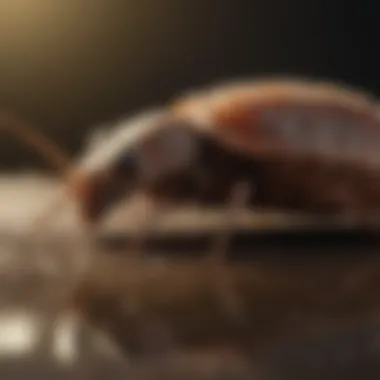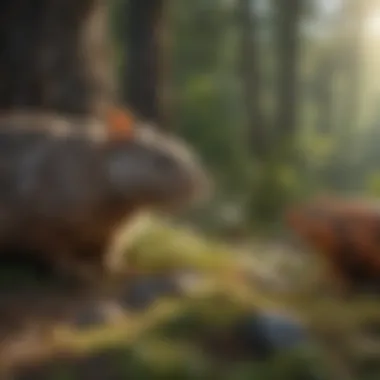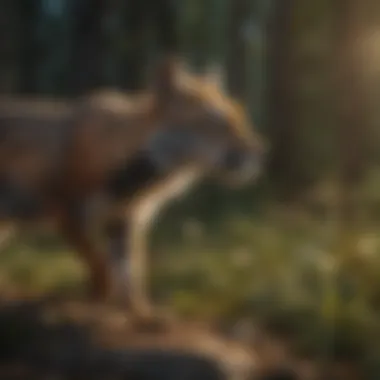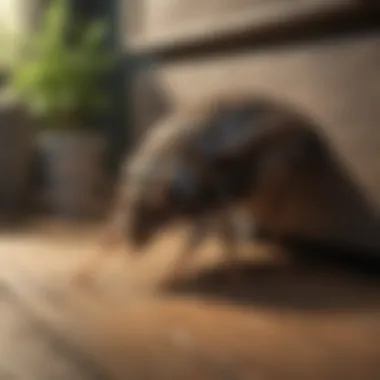Comprehensive Guide to Upstate Pest and Wildlife Control: Expert Insights and Strategies


Preventive Pest Control Strategies
Pest control starts with preventive measures that significantly reduce the chances of infestations in the first place. Taking care of your house exterior is crucial. Sealing cracks and gaps around windows, doors, and foundations can prevent pests from finding their way inside. Regularly clearing debris such as piles of leaves or wood can eliminate hiding spots for pests. Additionally, ensuring that your yard is well-maintained is essential. Pruning bushes and trees away from the house and keeping grass trimmed helps reduce hiding spots for pests like insects and rodents. Maintaining a clean indoor environment is equally important. Expert cleaning tips can help keep pests at bay by removing food sources and nesting grounds. Proper garbage disposal is often overlooked but plays a significant role in pest prevention. Using efficient waste disposal methods and securing trash bins can deter pests from being attracted to your property. Aside from these conventional strategies, exploring innovative ways to safeguard your home against pests can provide added protection.
Identifying Pest Risk Areas
To effectively manage pests, it's crucial to identify potential risk areas in and around your home. Inspecting moisture-prone areas such as basements and crawl spaces helps in detecting damp conditions conducive to pests. By implementing measures to address moisture issues, you can deter pests from thriving in these areas. Crack and crevice inspection is another essential step in pest prevention. Identifying access points where pests can enter your home and sealing them off can significantly impede infestations. Moreover, regularly inspecting greenery around your property can reveal potential pest risks. Maintaining vegetation properly and keeping it away from the house can help mitigate pest problems. Furthermore, addressing other miscellaneous risk areas that may vary depending on the property can further fortify your pest control efforts.
Effective Pest Control Methods
Implementing effective pest control methods is crucial for managing infestations. Utilizing natural repellents derived from essential oils, herbs, or plants can repel pests without harming the environment or residents. Additionally, using chemical sprays under professional guidance can eradicate stubborn pests effectively. Pest traps offer a humane solution for capturing and removing pests from your property. Biological control methods, such as introducing natural predators, can help in managing pest populations in an eco-friendly manner. Exploring innovative pest control methods beyond traditional options can provide tailored solutions for specific pest issues.
Pest Species Identification
Identifying the types of pests inhabiting your property is essential for formulating a targeted pest management plan. Common insects like ants, cockroaches, and spiders can be effectively managed by recognizing their behaviors and habitats. Rodents such as mice and rats pose significant challenges and require specialized prevention techniques. Certain bird species can also impact home environments negatively, requiring mitigation strategies to address associated problems. Wildlife encounters on your property demand a different approach, focusing on understanding their behavior and implementing suitable control measures. Managing lesser-known pests effectively involves thorough identification and tailored interventions.
DIY Pest Control Techniques
For those inclined towards a hands-on approach, do-it-yourself pest control techniques offer practical solutions. Homemade remedies using eco-friendly ingredients can help address pest concerns without harsh chemicals. Essential oils are effective natural repellents that create a bug-free environment at home. Setting up traps and barriers can aid in controlling pest infestations in specific areas. Many reputable pest control brands provide products for home management that are reliable and safe. Exploring various DIY techniques for different pest issues can empower homeowners to take control of their pest management.
Understanding Pest and Wildlife Control
Understanding Pest and Wildlife Control plays a vital role in effectively managing and eradicating pests and wildlife in upstate regions. It serves as the cornerstone of any pest control program, aiming to ensure the health and safety of individuals, protect property from damage, and maintain ecological balance. By comprehensively understanding the behavior and biology of various pests and wildlife, individuals can implement strategic control measures to mitigate infestations and conflicts. This section will delve into the essential components, benefits, and considerations surrounding the topic of Pest and Wildlife Control.
The Importance of Pest and Wildlife Control
Impact on Health and Safety
Effective pest and wildlife control directly impacts the health and safety of individuals and communities. Infestations of pests such as rodents, insects, birds, and large mammals can pose significant health risks through the transmission of diseases and contamination of living spaces. implementing pest control strategies not only protects the physical well-being of residents but also safeguards against potential allergic reactions and respiratory issues caused by pests. The systematic eradication and prevention of pest infestations contribute to creating a healthier living environment.
Preservation of Property
Preserving property from damage caused by pests and wildlife is a primary concern in pest control. Infestations of rodents, insects, and birds can lead to structural damage, contamination of food supplies, and destruction of landscaping. By addressing pest infestations proactively, individuals can safeguard their homes, businesses, and natural surroundings from costly repairs and irreversible harm. Implementing pest control measures ensures the longevity and integrity of properties in upstate areas.
Ecological Balance
Maintaining ecological balance is a fundamental aspect of pest and wildlife control. Each species plays a crucial role in the ecosystem, and the indiscriminate removal of pests can disrupt the natural balance. By adopting sustainable pest control practices that consider the ecological impact, individuals can prevent harmful repercussions on local flora and fauna. Promoting coexistence with wildlife while managing pest populations ensures the preservation of biodiversity and the stability of the ecosystem in upstate regions.
Common Pest and Wildlife Infestations in Upstate Areas
Rodents
Rodents such as mice and rats are prevalent pests in upstate areas, known for their ability to spread diseases, contaminate food supplies, and cause structural damage. These pests thrive in urban and rural environments, seeking shelter and sustenance in human habitats. Implementing rodent control measures is essential to prevent infestations and mitigate the health and safety risks associated with rodent presence.
Insects
Insects encompass a diverse range of pests, including ants, cockroaches, and mosquitoes, that infest homes and outdoor spaces in upstate regions. These pests not only pose health hazards through their bites and stings but also contribute to property damage and crop destruction. Utilizing integrated pest management techniques can effectively target insect infestations while minimizing the environmental impact of pest control methods.
Birds


Bird infestations, such as pigeons and sparrows, can create nuisances through their droppings, nesting habits, and noise pollution. These pests often inhabit roofs, attics, and outdoor areas, leading to unsanitary conditions and structural deterioration. Implementing bird exclusion methods and deterrents can discourage roosting and nesting behavior, thereby reducing the damage caused by bird infestations.
Large Mammals
Large mammals like raccoons, deer, and coyotes pose challenges in upstate regions due to their destructive foraging habits and conflicts with human activities. These animals can damage crops, gardens, and property while presenting risks of disease transmission. Employing humane wildlife control services that prioritize coexistence and ethical treatment can address large mammal infestations effectively while respecting the natural habitat and behavior of these wildlife species.
Legal and Ethical Considerations in Pest and Wildlife Control
Regulatory Framework
Compliance with regulatory frameworks governing pest and wildlife control is essential to uphold ethical standards and protect biodiversity. Laws and regulations dictate the permissible methods for managing pests and wildlife, emphasizing the importance of humane practices and environmental responsibility. Adhering to these legal frameworks ensures that pest control activities are conducted ethically, responsibly, and in harmony with existing wildlife populations and habitats.
Humane Practices
Incorporating humane practices in pest and wildlife control involves utilizing methods that prioritize the well-being and welfare of animals. Ethical considerations include the use of non-lethal traps, relocation of wildlife to suitable habitats, and mitigating human-wildlife conflicts through peaceful coexistence strategies. By adopting humane practices, individuals can address pest and wildlife issues compassionately while promoting sustainable solutions that respect the intrinsic value of all living creatures.
Effective Pest Control Strategies
In the realm of upstate pest and wildlife control, Effective Pest Control Strategies play a pivotal role in ensuring the safety and well-being of both humans and the environment. These strategies involve a proactive approach to managing pest infestations and wildlife encounters in a manner that is both effective and environmentally conscious. By focusing on prevention rather than reaction, these strategies aim to address issues before they escalate, thus minimizing the need for extreme measures.
Preventive Measures
Sealing Entry Points
When delving into Preventive Measures, one essential aspect is Sealing Entry Points. This technique involves identifying and closing off any potential entryways that pests or wildlife may use to access a property. By addressing these vulnerabilities, homeowners can significantly reduce the likelihood of infestations or intrusions.
Properly Sealing Entry Points is a fundamental step in pest control as it serves as the first line of defense against unwanted guests. The key characteristic of this method is its ability to block off common entry points such as gaps in walls, windows, or doors, effectively denying pests and wildlife easy access. This approach is a popular choice for this guide due to its proactive nature and long-term efficacy.
Chemical-Free Pest Control Options
Organic Sprays
Within the realm of Chemical-Free Pest Control Options, Organic Sprays stand out as a natural and environmentally friendly solution for addressing pest issues. These sprays utilize plant-based ingredients that are safe for both humans and pets while effectively deterring pests from inhabiting indoor or outdoor spaces.
Organic Sprays are favored in this guide for their non-toxic nature and ability to target specific pests without harming beneficial insects or the surrounding ecosystem. Their unique feature lies in their ability to provide targeted pest control without the use of harmful chemicals, making them a preferred choice for environmentally conscious individuals.
Integrated Pest Management Techniques
Monitoring
In the realm of Integrated Pest Management Techniques, Monitoring plays a crucial role in identifying pest populations and understanding their behavior patterns. By regularly monitoring pest activity, homeowners can detect infestations early on and implement appropriate control measures before the situation worsens.
Monitoring involves the systematic observation of pest activity through traps, inspections, and surveillance. Its key characteristic lies in its proactive nature, allowing homeowners to stay ahead of potential pest problems. This method is popular in this guide for its effectiveness in early detection and prevention of infestations.
Control Methods
Complementing monitoring, Control Methods are essential in effectively managing pest populations once detected. These methods encompass a range of techniques, from physical traps to biological control agents, tailored to address specific pest species in a targeted and efficient manner.
Control Methods stand out for their versatility and efficacy in combatting pests while minimizing environmental impact. Their unique feature lies in their adaptability to various pest species, making them a valuable choice for addressing diverse pest challenges in an environmentally conscious manner.


Wildlife Management Approaches
Specific elements of Wildlife Management Approaches include the utilization of methods that prioritize the well-being of both humans and animals. By integrating ethical practices, such as humane wildlife removal methods, habitat modification, and professional wildlife control services, individuals can achieve long-term solutions to pest and wildlife conflicts.
The benefits of adopting Wildlife Management Approaches extend beyond mere pest control. By implementing humane techniques, individuals contribute to the preservation of biodiversity, ecological balance, and foster a harmonious relationship with local wildlife populations. Considerations about Wildlife Management Approaches should revolve around the dual goals of effectively managing pest issues while respecting the inherent value of wildlife in the ecosystem.
Humane Wildlife Removal Methods
Live Trapping
Live trapping is a specific technique within the realm of humane wildlife removal methods that plays a significant role in ensuring the safe capture and relocation of nuisance wildlife species. Unlike traditional lethal control methods, live trapping aims to capture animals unharmed, allowing for their subsequent release into suitable habitats away from human dwellings.
Key to live trapping is its emphasis on minimizing harm to wildlife, promoting ethical wildlife management practices, and offering a compassionate approach to conflict resolution. This method is particularly beneficial in scenarios where the humane removal of animals is desired without resorting to lethal measures.
The unique feature of live trapping lies in its ability to offer a non-lethal alternative to pest and wildlife control. While advantageous in its humane nature and ability to prevent unnecessary suffering to animals, live trapping may pose challenges in terms of selecting appropriate release sites and ensuring the welfare of captured animals post-release.
Exclusion Devices
Exclusion devices represent another important facet of humane wildlife removal methods, focusing on preventing wildlife entry into buildings or specific areas while allowing for the safe exit of present animals. By employing physical barriers or mechanisms that deter wildlife from unwanted spaces, exclusion devices offer a proactive and non-lethal solution to wildlife conflicts.
The key characteristic of exclusion devices lies in their effectiveness in promoting cohabitation and deterring wildlife without causing harm. This method is a popular choice for individuals seeking long-term prevention of wildlife intrusions without resorting to harmful control measures.
The unique feature of exclusion devices lies in their ability to target specific entry points or areas vulnerable to wildlife access, thereby offering a targeted and sustainable management solution. While advantageous in its non-invasive approach and focus on prevention, exclusion devices may require regular maintenance and monitoring to ensure continued effectiveness.
Habitat Modification
Vegetation Management
Vegetation management plays a vital role in habitat modification for wildlife control purposes, focusing on altering plant compositions to discourage wildlife presence in specific areas. By strategically managing vegetation, individuals can create environments less favorable to pest species while promoting biodiversity and ecosystem health.
The key characteristic of vegetation management is its capacity to shape habitats in ways that deter wildlife without causing harm, offering a natural and sustainable approach to pest control. This method is a beneficial choice for individuals seeking environmentally friendly solutions to wildlife conflicts.
The unique feature of vegetation management lies in its ability to address underlying factors that attract wildlife, such as food and shelter, thereby preventing infestations naturally. While advantageous for promoting ecosystem health and reducing pest pressures, vegetation management may require ongoing maintenance and monitoring to sustain its effectiveness.
Structural Adjustments
Structural adjustments encompass physical modifications made to buildings or structures to deter wildlife from accessing or residing within human-inhabited spaces. By fortifying structures and eliminating entry points, individuals can effectively prevent wildlife intrusions and mitigate potential conflicts with nuisance species.
The key characteristic of structural adjustments is their focus on long-term solutions that address the root cause of wildlife conflicts, offering a durable and practical approach to pest management. This method is a popular choice for individuals seeking to safeguard their properties from wildlife damage.
The unique feature of structural adjustments lies in their ability to provide lasting protection against wildlife intrusions, thereby reducing the need for reactive control measures. While advantageous in its permanence and effectiveness, structural adjustments may require initial investment and periodic upkeep to ensure continued efficacy.
Professional Wildlife Control Services
In the realm of wildlife management, professional wildlife control services play a pivotal role in addressing complex pest and wildlife issues effectively. By enlisting the expertise of experienced wildlife professionals, individuals can access specialized knowledge, tools, and resources to tackle challenging wildlife conflicts with precision and efficiency.
Benefits
Professional wildlife control services offer a range of benefits, including expert assessment, customized wildlife management plans, and safe removal techniques. By partnering with professionals, individuals can ensure the humane and effective resolution of wildlife conflicts while safeguarding their properties and well-being.


The key characteristic of benefits provided by professional wildlife control services is their comprehensive approach to wildlife management, tailored to individual needs and environmental considerations. This service is a beneficial choice for individuals facing persistent or complex wildlife issues requiring specialized solutions.
The unique feature of professional wildlife control services lies in their ability to deliver timely and sustainable interventions that address wildlife conflicts while prioritizing the safety of both humans and animals. While advantageous in their efficiency and expertise, professional services may incur costs depending on the scope of the work involved.
Considerations
When considering professional wildlife control services, individuals should weigh various factors such as service reputation, methods used, and overall alignment with ethical and legal considerations. By evaluating these aspects, individuals can make informed decisions regarding the selection of wildlife control services that best meet their needs and values.
The key characteristic of considerations in professional wildlife control services lies in their role in ensuring ethical practices, compliance with regulations, and transparent communication throughout the wildlife management process. These considerations are essential for creating successful partnerships with wildlife professionals and achieving sustainable wildlife management outcomes.
The unique feature of considerations surrounding professional wildlife control services is their emphasis on ethical standards, ecological impact, and long-term effectiveness. While advantageous in their ability to provide expert assistance and tailored solutions, considerations also entail the need for thorough research and due diligence when engaging wildlife control services.
Challenges in Upstate Pest and Wildlife Control
Challenges in Upstate Pest and Wildlife Control play a pivotal role in this insightful guide, shedding light on the various obstacles that individuals may encounter when dealing with pest and wildlife issues in upstate regions. Understanding these challenges is crucial for effective management and conservation efforts. By addressing a range of factors like environmental impact, resilience in pest species, and population growth, this section aims to equip readers with the knowledge needed to navigate the complexities of pest and wildlife control successfully.
Environmental Impact
Non-Target Species
In the realm of pest and wildlife control, non-target species present a significant consideration with their impact on ecosystems. These species, unintended recipients of control methods, can suffer detrimental effects if not accounted for in management strategies. Recognizing the key characteristic of non-target species ensures a balanced approach to control, considering the broader ecological implications. While their presence can unintentionally disrupt the ecosystem, measures can be taken to mitigate harm and promote coexistence where possible. Understanding the nuances of non-target species is essential for maintaining biodiversity and ecosystem resilience in upstate areas.
Soil and Water Contamination
Soil and water contamination are pressing concerns linked to the pesticide use and control efforts employed in upstate pest management. The key characteristic of soil and water contamination lies in its potential to disrupt natural processes and harm environmental health. While these control methods can effectively target pests, they also pose risks to water sources and soil quality if not managed carefully. Balancing the need for pest control with mitigating contamination risks is crucial for sustainable practices in upstate environments. Addressing soil and water contamination aligns with the overall goal of maintaining a healthy ecosystem while addressing pest issues effectively.
Resilient Pest Species
Adaptation to Control Methods
Resilient pest species showcase their ability to adapt to a variety of control methods, presenting a considerable challenge to traditional pest management strategies. The key characteristic of these species lies in their capacity to evolve and overcome control measures, necessitating a dynamic approach to control efforts. Understanding how pests adapt to control methods is crucial for developing innovative strategies that can effectively target these resilient species while minimizing environmental impact. By recognizing and addressing their adaptability, pest management practices can become more robust and sustainable in upstate regions.
Population Growth
Population growth in pest species poses a significant challenge to pest control efforts, impacting both ecosystems and human environments. The key characteristic of population growth lies in its exponential nature, requiring proactive measures to prevent outbreaks and widespread infestations. Addressing population growth through targeted control strategies is essential for maintaining biodiversity and preventing potential health and safety risks. By understanding the factors contributing to population growth, individuals can implement tailored solutions that promote sustainable management practices in upstate pest control. Tackling population growth is a critical aspect of effective pest management, ensuring long-term success in controlling pest populations and safeguarding ecosystems.
Future Directions in Pest and Wildlife Control
In this section, we shed light on the critical aspects of future directions in pest and wildlife control within the scope of this comprehensive guide. The future of pest and wildlife control holds paramount importance due to the constantly evolving challenges posed by pests and wildlife in upstate regions. By focusing on specific elements, benefits, and considerations concerning future directions, we aim to equip individuals with the knowledge necessary to adapt to emerging trends and advancements in the field.
Technological Advancements
Remote Monitoring
Delving into the realm of remote monitoring, we uncover its pivotal role in revolutionizing pest and wildlife control practices. Remote monitoring offers a game-changing approach by enabling real-time surveillance and data collection, fostering a proactive response to potential infestations. A key characteristic of remote monitoring is its ability to provide continuous monitoring without the need for physical presence, making it a highly sought-after choice for enhancing monitoring efficiency in challenging terrains or vast upstate areas.
The unique feature of remote monitoring lies in its capacity to detect early signs of pest activity, facilitating timely interventions to prevent widespread infestations. While its advantages encompass improved accuracy in monitoring, timely alerts, and reduced labor costs, its limitation may lie in initial setup expenses and potential technical glitches that may hinder seamless operation.
Precision Treatment
Exploring precision treatment unveils its significant contribution to enhancing pest and wildlife control efficacy. Precision treatment focuses on targeted approaches that deliver specific treatments to affected areas with pinpoint accuracy. This precision minimizes collateral damage to non-target species and the environment, ensuring a more sustainable and effective control strategy.
The key characteristic of precision treatment is its customized approach, tailoring treatments to specific pest species and infestation severity levels. This individualized method increases treatment efficiency and reduces the need for broad-spectrum chemicals, aligning with eco-friendly practices increasingly favored in pest and wildlife control.
In terms of unique features, precision treatment stands out for its ability to reduce environmental impact by minimizing chemical usage and promoting precise application. While its advantages include reduced chemical exposure risks, targeted control outcomes, and long-term cost-effectiveness, some challenges may involve initial setup costs and the need for specialized expertise in application techniques.



